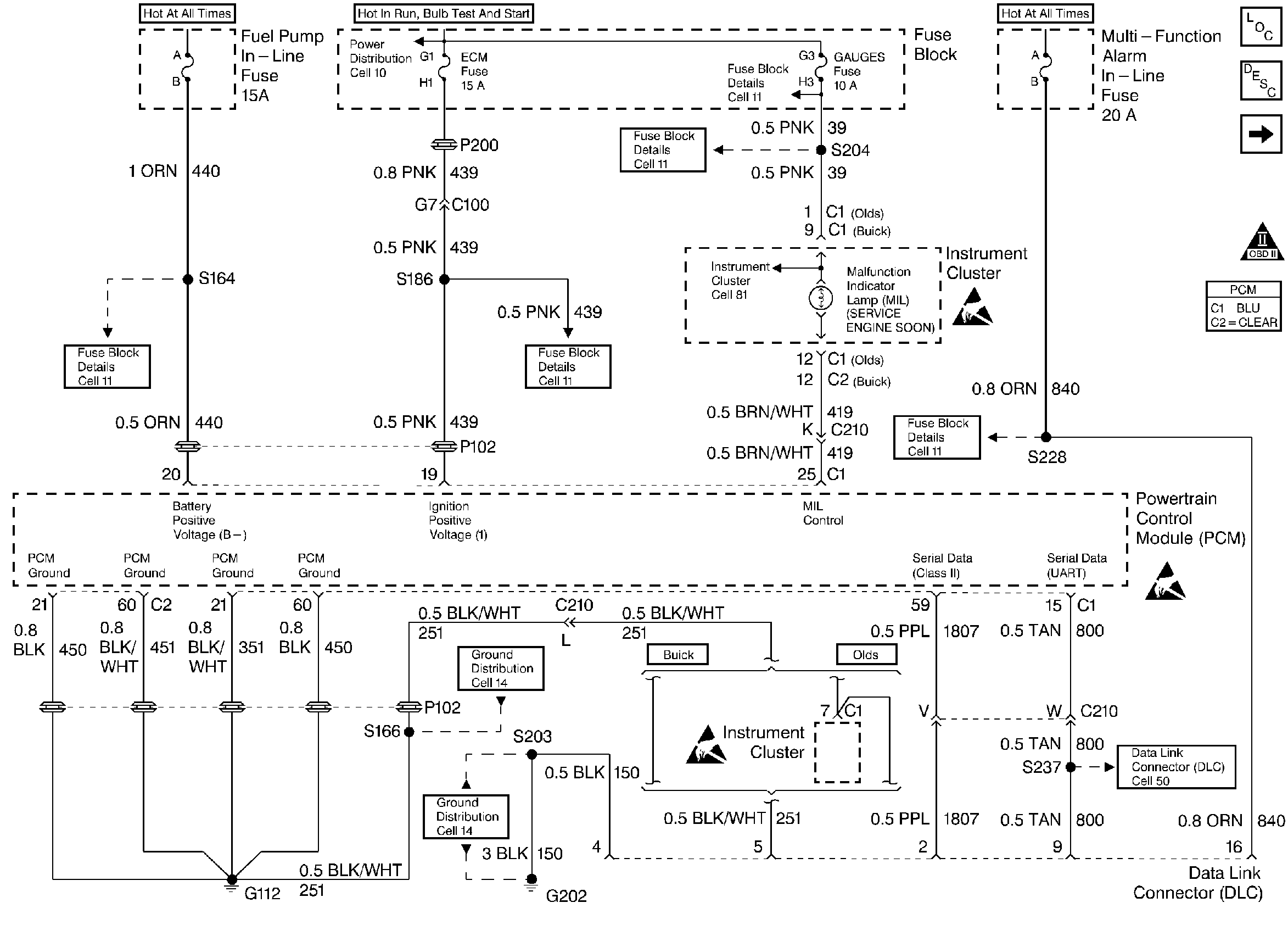Refer to
MIL, Instrument Panel, and the DLC

Circuit Description
The PCM controlled lamps are powered through the IGN 1 fuse. The PCM turns ON the bulb, LED, or driver info center indicator by supplying a path to ground through the PCM.
Diagnostic Aids
A PCM controlled lamp ON at all times most likely indicates that a condition is present which requires the attention of the vehicle operator. Conditions which will illuminate each lamp are as follows:
| • | GENERATOR LAMP will be illuminated under any of the following conditions: |
| - | When the engine speed is greater than 1200 RPM and system voltage falls below 9 volts for longer than 25 seconds. The PCM commands the generator lamp OFF when system voltage rises to above 12 volts. |
| - | When the generator control circuit (L terminal) remains low for longer than 25 seconds. |
For diagnosis of the instrument panel, perform the System Check in the Instrument Cluster section of Electrical Diagnosis.
Check for the following conditions:
| • | Poor connection at PCM. Inspect harness connectors for backed out terminals, improper mating, broken locks, improperly formed or damaged terminals, and poor terminal to wire connection. |
| • | Damaged harness. Inspect the wiring harness for damage. If the harness appears to be OK, disconnect the PCM and turn the ignition ON. Observe a voltmeter connected to the affected PCM output circuit while moving connectors and wiring harnesses related to the PCM output circuit. A change in voltage will indicate the location of the fault. |
Test Description
The numbers below refer to the step numbers on the Diagnostic Table.
-
Normally, ignition feed voltage should be present on the output driver circuit with the PCM disconnected and the ignition turned ON.
-
Checks for a shorted component or a short to B+ on the output driver circuit. Either condition would result in a measured current of over 1.5 amps. Also checks for a component that is going open while being operated, resulting in a measured current of 0 amps.
-
Checks for a faulty instrument cluster.
-
This vehicle is equipped with a PCM which utilizes an Electrically Erasable Programmable Read Only Memory (EEPROM). When the PCM is being replaced, the new PCM must be programmed. Refer to PCM Replacement/Programming.
Step | Action | Value(s) | Yes | No |
|---|---|---|---|---|
1 | Was the Powertrain On-Board Diagnostic (OBD) System Check performed? | -- | Go to Powertrain OBD System Check | |
2 | Was the instrument cluster system check in Electrical Diagnosis performed? | -- | Go to Electrical Diagnosis | |
Is voltage near the specified value? | B+ | |||
Does the current reading remain between the specified values? | 0.05 amp 1.5 amps | |||
Is voltage at the specified value? | 0V | |||
6 | Locate and repair short to voltage in affected PCM output circuit. Is action complete? | -- | -- | |
7 | Check the ignition feed fuse for the instrument panel cluster indicator lamps. Is the fuse blown? | -- | ||
8 |
Is action complete? | -- | -- | |
9 |
Is voltage near the specified value? | B+ | ||
10 |
Was a problem found? | -- | ||
11 |
Was a problem found? | -- | ||
12 |
Does the test light flash ON and OFF? | -- | Go to Diagnostic Aids | |
13 |
Was a problem found? | -- | ||
14 | Locate and repair open in ignition feed circuit to the instrument panel cluster indicator lamps. Refer to Engine Electrical. Is action complete? | -- | -- | |
15 | Replace the instrument panel cluster. Is action complete? | -- | -- | |
Replace the PCM. Important: Program the replacement PCM. Refer to PCM Replacement/Programming . Is action complete? | -- | -- | ||
17 | Operate the affected lamp using the scan tool output tests function. Does the affected lamp operate properly? | -- | System OK |
